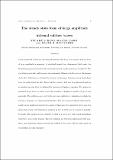Files in this item
The steady-state form of large-amplitude internal solitary waves
Item metadata
| dc.contributor.author | King, Stuart Edward | |
| dc.contributor.author | Carr, Magda | |
| dc.contributor.author | Dritschel, David Gerard | |
| dc.date.accessioned | 2011-12-05T09:33:49Z | |
| dc.date.available | 2011-12-05T09:33:49Z | |
| dc.date.issued | 2011-01-10 | |
| dc.identifier | 471402 | |
| dc.identifier | 2e79bf07-e74c-4480-bc5e-5d6bfa049374 | |
| dc.identifier | 79951682334 | |
| dc.identifier | 000287053100018 | |
| dc.identifier.citation | King , S E , Carr , M & Dritschel , D G 2011 , ' The steady-state form of large-amplitude internal solitary waves ' , Journal of Fluid Mechanics , vol. 666 , pp. 477-505 . https://doi.org/10.1017/S0022112010004301 | en |
| dc.identifier.issn | 0022-1120 | |
| dc.identifier.other | standrews_research_output: 32423 | |
| dc.identifier.other | ORCID: /0000-0001-6489-3395/work/64697797 | |
| dc.identifier.uri | https://hdl.handle.net/10023/2084 | |
| dc.description.abstract | A new numerical scheme for obtaining the steady-state form of an internal solitary wave of large amplitude is presented. A stratified inviscid two-dimensional fluid under the Boussinesq approximation flowing between horizontal rigid boundaries is considered. The stratification is stable, and buoyancy is continuously differentiable throughout the domain of the flow. Solutions are obtained by tracing the buoyancy frequency along streamlines from the undisturbed far field. From this the vorticity field can be constructed and the streamfunction may then be obtained by inversion of Laplace's operator. The scheme is presented as an iterative solver, where the inversion of Laplace's operator is performed spectrally. The solutions agree well with previous results for stratification in which the buoyancy frequency is a discontinuous function. The new numerical scheme allows significantly larger amplitude waves to be computed than have been presented before and it is shown that waves with Richardson numbers as low as 0.062 can be computed straightforwardly. The method is also extended to deal in a novel way with closed streamlines when they occur in the domain. The new solutions are tested in independent fully nonlinear time-dependent simulations and are verified to be steady. Waves with regions of recirculation are also discussed. | |
| dc.format.extent | 35801423 | |
| dc.language.iso | eng | |
| dc.relation.ispartof | Journal of Fluid Mechanics | en |
| dc.subject | Internal waves | en |
| dc.subject | Solitary waves | en |
| dc.subject | Stratified flows | en |
| dc.subject | QA Mathematics | en |
| dc.subject.lcc | QA | en |
| dc.title | The steady-state form of large-amplitude internal solitary waves | en |
| dc.type | Journal article | en |
| dc.contributor.sponsor | EPSRC | en |
| dc.contributor.institution | University of St Andrews. School of Mathematics and Statistics | en |
| dc.contributor.institution | University of St Andrews. Scottish Oceans Institute | en |
| dc.contributor.institution | University of St Andrews. Applied Mathematics | en |
| dc.contributor.institution | University of St Andrews. Marine Alliance for Science & Technology Scotland | en |
| dc.identifier.doi | 10.1017/S0022112010004301 | |
| dc.description.status | Peer reviewed | en |
| dc.identifier.url | http://www.scopus.com/inward/record.url?scp=79951682334&partnerID=8YFLogxK | en |
| dc.identifier.grantnumber | EP/F030622/1 | en |
This item appears in the following Collection(s)
Items in the St Andrews Research Repository are protected by copyright, with all rights reserved, unless otherwise indicated.

